Fiddle Leaf Fig / Ficus Lyrata: Multiple Trunks into One?
I just got a fiddle leaf fig. As you can see, it looks pretty hearty and healthy. It has three "trunks" that are rather thin right now. I'd like to figure out a way to merge them into one, sort of the like the last photo below.

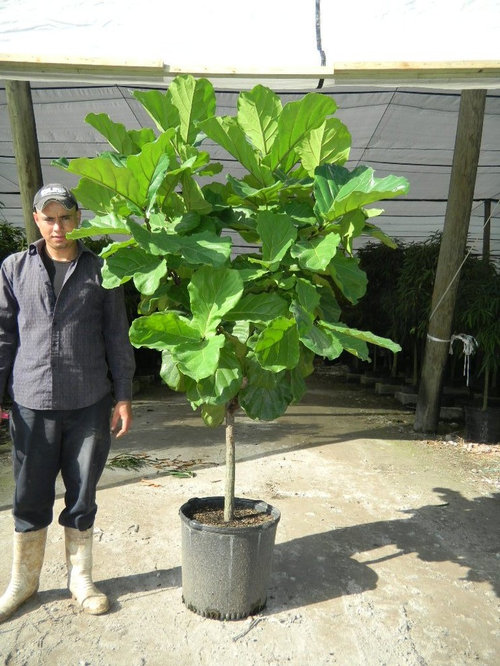
I've read multiple suggestions online: from braiding the trunk together to full-on separating the trunks into separate pots, in the summer, when the season is right and the plant is still healthy.
Apologies for posting a question that may have already been answered, but I thought I'd shoot another out there that is a bit straightforward. Thanks.
Comments (172)
jhick3
6 years agoHi Al,
I have read through all of the super helpful info in this thread and got tons of tips to take care of my plant. I have had my Ficus for 3 months... where are two plants in one pot. The pot size is 5 1/2" tall and the diameter at the top is 6". After reading the tread about I believe I did overwater a bit. However... the one plant is looking fine and growing new leaves often while the second plant is looking very brown and shrivelled. I am confused... they are in the same pot and one is doing great while the other is looking so sad. Should I remove the leave or remove the sad plant all together?
Thank you!!!
Jessica
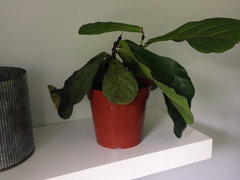


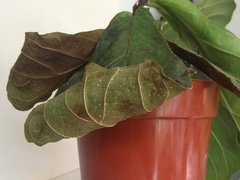
tapla (mid-Michigan, USDA z5b-6a)
6 years agoHi, Jessica. I think it just depends on what you want ....... Do you want a composition that ends up looking natural, as in a tree with 2 trunks that essentially has a canopy that looks as though it has just 1 trunk,

or do you want a composition that actually DOES have only one trunk? My perspective re F elastica and lyrata is that they both have leaves so large they end up being an impediment to the grower's ability to create a composition with leaves in proportion to the o/a size of the tree. No one should allow that idea to diminish the fun or satisfaction of growing a healthy plant of either species, but something like F retusa or benjamina would be much easier to mold into a more proportionate tree.
I DK if you've read this anywhere here, yet, but after you water to beyond the saturation point, hold your plant over the sink and move it downward then sharply upward. As you transition from down to up, the water in the pot will want to maintain its downward inertia. You can rid even VERY water-retentive soils of all their excess water by employing Newton's First Law of Motion as described. At a minimum, this allows you to flush the soil of accumulating salts any time you like, as long as the plant/pot/composition is light enough to easily manage. Even when it becomes so large it's difficult to manage, there are other tricks that directly employ science to work on your behalf to ease the limitations of poor drainage/aeration.
AlRelated Professionals
Londonderry Landscape Architects & Landscape Designers · Beavercreek Landscape Architects & Landscape Designers · Kyle Landscape Architects & Landscape Designers · Rancho Palos Verdes Landscape Architects & Landscape Designers · Aberdeen Landscape Contractors · Chesapeake Ranch Estates Landscape Contractors · Fruit Heights Landscape Contractors · Hannibal Landscape Contractors · Merced Landscape Contractors · New Providence Landscape Contractors · Painesville Landscape Contractors · Round Lake Landscape Contractors · Palos Hills Landscape Contractors · Forest Hill Landscape Contractors · Casselberry Landscape ContractorsHU-652525
6 years agoHi Al, I've been reading through this forum and wondering if I could also ask for your advice as I am struggling with my ficus lyrata.
I bought it several months ago now from a nursery, and I have had no growth from it at all. There is one bud at the top which has been like that for several months but never spouting a leaf. (1st picture below). I am not sure why there has been no growth in all the time I have had it. I repotted it thinking that might help but realised that that was maybe unnecessary.
I was also wondering if you could give instructions/advice on how to make a single trunked ficus grow branches into a tree? I've read on this forum that this is done by 'notching'? Could you explain how this is done. (sorry my plant knowledge is not very good!)
Ash
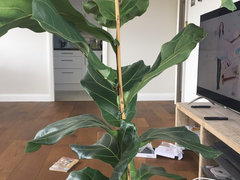
jhick3
6 years agoThank you Al! I would like to keep both trees. Will the one with brown leaves still survive if I let the plant dry out and water it less? The healthy plant is continuing to shoot new leaves but the one with brown leaves isn't showing any signs of new growth at the top.
Ralphenia Dybdahl
6 years agoNeeding some help. I have a new leaf on my FLF that looks odd. Any insight?

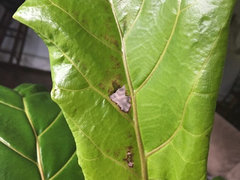
tapla (mid-Michigan, USDA z5b-6a)
6 years agoAsh - I would get your plant in front of a bright window, flush the soil the next time it needs water and fertilize at that point. I'd recommend a recommended concentration of Foliage-Pro 9-3-6. After that, monitor water needs carefully and only water when the soil is about to become dry to the bottom. You want to water immediately before the soil becomes completely dry deep in the pot.
Jhick - It's not unusual for one of 2 or more cuttings in the same container to simply give up spontaneously/idiopathically. It happens. I can't say what went wrong, or whether the plant will make it. Just provide conditions the plant likes and wait to see what develops, or doesn't.
Ralphenia - If it's a fairly new leaf that emerged while central heat or air conditioning was in use, it's likely due to low humidity causing the leaf to stick to itself and tear as it unfurled. Can't add more w/o more info.
Al
kate_lee6
6 years agoHi Al (and all others willing to help!)
I have a few questions about my three-trunked fiddle leaf fig tree (I'm pretty sure it's three separate plants in one pot). I've added background information and pictures below, but here's a short list of the questions in case you only want to skim the wall of text below:
- Is it normal to lose a few leaves from the bottom of the plant if those leaves are blocked from the sun?
- Two of the three plants are growing, but the third is not. Should I be worried? And if so, what should I do to fix it?
- Last, if you can tell anything from pictures, I'd love a general health assessment on my plant and advice about what I should do moving forward.
Background:
I bought the FLF from a well-respected local nursery in my city (zone 8a) on April 19th, brought it home, and plopped it right in front of my western-facing window where I get lots of bright afternoon sun. The tree when I first brought it home:

It's been in pretty much that same spot for about a month and a half. I water it when the top ~1-2 inches of soil are dry and I just start to see the leaves droop a bit--about every 7-9 days. I set the plant in a plastic tub, water it until water starts to run out the bottom of the nursery pot, leave it for a minute to make sure everything has drained, and then put the pot back into the planter. I also rotate it 1/4 turn every week.
Otherwise, I've heeded the nursery employee's advice and have tried not to stress it out much since I've gotten it home. I did set it up on a plant stand that raises it up off the ground by about 8 inches, but it's in the same 14" nursery pot and soil that I got it in. I have no idea if the potting soil is good, bad, or somewhere in between. When it is time to re-pot (whether that's sooner or later, depending on your advice), I plan to use the 5:1:1 mix that's always mentioned around here. Here's a photo of the whole plant now:

First question: Lower leaves falling off
Since I've gotten the plant, I've lost about 4 or 5 lower leaves, all of which were ones that were pretty much entirely blocked by other leaves. As you can tell from the pictures above, even when I got the plant, a lot of the lower leaves were pretty crowded and pointed downward, which blocks some of the other lower leaves from getting any sunlight. Here's are some more recent photos of the plant and a couple of lower leaves that are starting to brown around the edges:
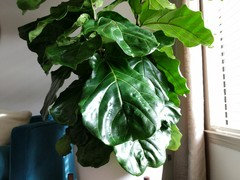
One of the leaves that is starting to turn brown (I had to lift the other leaves up to see it, as it's completely covered)
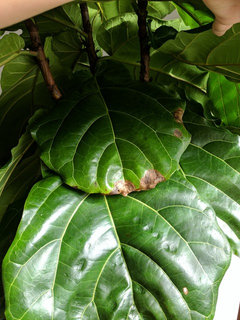
Here's another tiny leaf on the bottom that is threatening to fall off, and you can see that one of the others is starting to turn brown near the stem:

I know leaves can brown and fall off from over-watering-- do you think that is the cause of leaf loss on my plant, or are they falling off because the leaves just aren't getting enough sun? And what causes the leaves to point downward?
Second Question: One of the three plants isn't growing
Since I got the tree, two of the three stems have each grown about a foot, adding 5 more leaves (3 on one, two on the other).
3 new leaves!

2 new leaves!
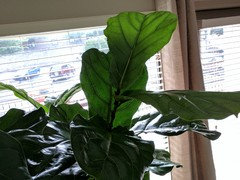
And then there's stumpy, which hasn't grown at all and is now considerably shorter than the other two:

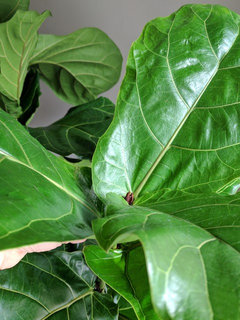
Here is a photo of the roots/soil:
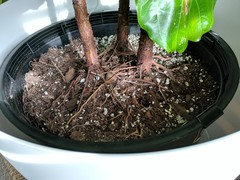
What could be causing the mismatched growth? Do I just need to be more patient, or does the pot perhaps not have enough room for all three to grow? I haven't re-potted or fertilized the plant out of fear that it would be too stressful this soon after taking it home. But I've also read that this time of year is the best time to do so. If it is overcrowding, which is worse? Leaving the plant crowded for another year, or stressing it out soon after a move?Last question:
I want to help my beautiful fig tree thrive, and I've done a lot of research (thanks largely to this forum!). But, I would appreciate any insight you have about how my plant looks now, and what (if any) changes I should make.
Many thanks!!
tapla (mid-Michigan, USDA z5b-6a)
6 years agolast modified: 6 years ago- Is it normal to lose a few leaves from the bottom of the plant if those leaves are blocked from the sun? Plants are reactionary organisms that respond to cultural stimuli in fairly predictable ways. Anything they do then, is normal. A minimum flow rate of a hormone (auxin) that's produced in most tissues, but primarily in meristematic and leaf tissues, is required across a zonal area at the base of each leaf stem. The zonal area is called the abscission zone, and once the flow of auxin drops below the minimum required, a corky layer forms in the zone that cuts off water and nutrient flow to the leaf and photosynthate (food/sugar) to other organs. The abscission layer is not reversible and causes shedding of the leaf. There are several conditions/stimuli that can limit the flow of auxin, and a significant decrease in light levels, for any reason, is one potentiality.
- Two of the three plants are growing, but the third is not. Should I be worried? And if so, what should I do to fix it? Plants that are not growing are dying. This can be said because plants that are making more food/energy than they are using are always growing, and plants that are using more energy than they are making are not growing or actually losing weight through shedding of parts. Increase/decrease in dry mass is the true measure of growth - or how far a plant has backslid. From this, you can see there is cause for concern, at least for the plant that isn't growing, and probably for the others as well, seeing that all share the same cultural conditions.
- Last, if you can tell anything from pictures, I'd love a general
health assessment on my plant and advice about what I should do moving
forward. A couple of images showing individual leaves with some necrotic areas seem to indicate some periods of over-watering, but nothing too serious.
I think the best advice anyone can give as a starting point is, make sure your plant is in a soil that allows you to water correctly, that is to say, to beyond the point of saturation, so you're flushing the soil of accumulating dissolved solids (salts) when you water. Of course, that requires you to acquire some basic information about how/why water behaves as it does in soils. An appropriate or highly appropriate soil makes maintaining good root health soo much easier, and a healthy root system is a prerequisite to a healthy plant. One can't be had w/o the other. It also makes fertilizing (a crucial consideration) monkey easy. Beyond that, light levels and temperature are also a big part of maintaining plants at a high level of vitality.
This Basic Overview
should answer a lot of questions. If after looking it over you have other questions, don't hesitate.
Al
kate_lee6
6 years agoThanks Al! I have read through the basic overview, which is how I found out about the soil mixture you recommend. Since I've only had my plant a month and a half, I guess my question is: which is worse--potting it into new soil and risking stressing it out more, or leaving it in the soil it's currently in? Also, would you recommend potting up a size or just trying it in a new soil for now?
Last, I still have questions about why all my lower leaves point downward. It was like that when I got the plant, and I'm worried that is at least part of the reason some of the lower leaves are shedding. Is there anything to do to reverse this?
chloeprice427
6 years agoAl (or anyone else willing to help),
I just bought a FLF from home depot. The gardening expert who works there gave me 50% off the tree because he said none of the FLFs that he has are doing very well. It was only $10 so I decided to get the tree and take a chance on making it happy and healthy. Since he said the other plants aren't doing well, I was thinking I would repot like you recommend (not pot-up), get a completely new soil, and start from scratch. I read through most of this whole thread and what I've learned is to use a soil that doesn't retain water, has large particles, and allows aeration in the soil. I'm pretty new to houseplants so is there a soil you recommend that fits those requirements? I'm assuming you don't recommend putting stones in the bottom of the container? I was thinking of repotting the tree into a medium container with only soil in the container and holes at the bottom for drainage, then putting that container into a bigger, ceramic container with stones at the bottom. That way the soil doesn't collect water at the bottom, and there's a place for the water to go after watering. I live in a pretty dry area (Sunnyvale, California) and thought this would also help with humidity as well. What are your thoughts?
There are two trunks in the pot I got, both of which are about 3 ft tall with no branches. Eventually, I'd like to mold them into a tall tree shaped plant. I know this takes a long time, which I'm willing to invest in. I was wondering if the best plan to do this is to separate them into two separate pots, or to bind the two stems together to make one thicker trunk. Also, in order to encourage branching, I read that notching can be done, but I've never done that before, so is there a link you can give me with more information about that?
Last question is about the leaves themselves. The plant overall seems to be doing pretty well, but I have noticed that most of the leaves are curled at the edges instead of being flat. Is this normal? If not, what can I do to fix it?
Thanks so much in advance. I have learned so much already from you just by reading this feed and your attached articles, and I'm looking forward to learning more!


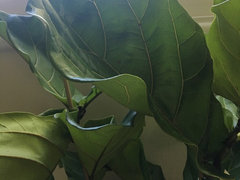
tapla (mid-Michigan, USDA z5b-6a)
6 years agoI read through most of this whole thread and what I've learned
is to use a soil that doesn't retain water, has large particles, and
allows aeration in the soil. I'm pretty new to houseplants so is there a
soil you recommend that fits those requirements? I's quite difficult to find a medium 'off the shelf' that isn't extremely water-retentive. To some degree, you can work around some of the ill effects associated with water-retentive soils, but why constantly battle your soil for control over your plant's vitality? It's easy to make your own soil, hardest part being the search for a suitable bark product. Once you find a source for bark that's suitable, it's easy from that point forward. I'm assuming you don't
recommend putting stones in the bottom of the container? Using things like gravel as a "drainage layer" causes water to perch in the soil above it. The first image (below) is where the perched water resides in a planting w/o a drainage layer when using soils that support perched water. The middle image illustrates how water perches in soils above a drainage layer, and the last image shows how you can use rocks, bricks, empty soda bottles with lids on, as ballast. You can see that the ht of the PWT is the same in all 3 cases, but there is less soil capable of holding perched water when you use ballast. You can do away with at least 95% of your soils ability to hold perched water if you use ballast judiciously.
I was thinking
of repotting the tree into a medium container with only soil in the
container and holes at the bottom for drainage, then putting that
container into a bigger, ceramic container with stones at the bottom.
That way the soil doesn't collect water at the bottom, and there's a
place for the water to go after watering. I live in a pretty dry area
(Sunnyvale, California) and thought this would also help with humidity
as well. What are your thoughts? That arrangement can be beneficial in some ways, but it doesn't do anything to increase drainage or decrease the amount of excess water your soil can/will hold.There are two trunks in the pot I got, both of which are about 3 ft
tall with no branches. Eventually, I'd like to mold them into a tall
tree shaped plant. I know this takes a long time, which I'm willing to
invest in. I was wondering if the best plan to do this is to separate
them into two separate pots, or to bind the two stems together to make
one thicker trunk. You can still create a single tree image when more than 1 or 2 trunks are part of the composition.^^ Two trunks - looks like 1 tree.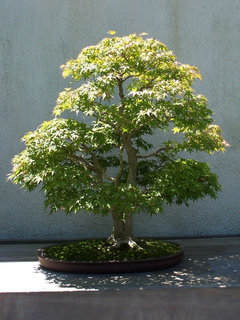
Also, in order to encourage branching, I read that
notching can be done, but I've never done that before, so is there a
link you can give me with more information about that? I think I'm going to have to write something about notching and save it as a word document ..... the subject comes up so often.Last question is about the leaves themselves. The plant overall seems
to be doing pretty well, but I have noticed that most of the leaves are
curled at the edges instead of being flat. Is this normal? If not, what
can I do to fix it? I wouldn't say it's abnormal. In some plants, it's a reaction to very strong light; it can be related to nutrition; and, it can also be a genetic trait.Thanks so much in advance. I have learned so much already from you
just by reading this feed and your attached articles, and I'm looking
forward to learning more! Those that invest some time in finding reliable information that directly helps them identify and eliminate those things that are limiting their plants, leave the trial-and-error crowd standing in their slipstream; so, even if I tried, I couldn't overemphasize the value of gaining knowledge ant then using your practical experience to validate what you already know. It's more productive by an incredible margin than trial and error. This is mainly true because in most cases, a good measure of knowledge is required to interpret the results of your trials & errors. If you misinterpret the results of your trial & error efforts gone awry, your efforts are wasted ..... at least from the perspective of learning something.Al
litterbuggy (z7b, Utah)
6 years agolast modified: 6 years agoDang it, Al, I thought I saved the stuff I found recently about notching after I did a search to help someone else, but I guess I didn't, probably because it's not something I need to do.
Chloe, if you enter the word "notching" in the search box at the top of the page you should get threads where Al has posted full explanations of how notching works and how to actually do it.
tapla (mid-Michigan, USDA z5b-6a)
6 years agolast modified: 6 years agohttp://forums2.gardenweb.com/discussions/1482912/encourage-branching-by-cuttling-a-leaf-in-half?n=10
Scan through the short thread above. Most of the info re notching will be found in the last post.
Al
ABB
6 years agoAl,
I have a fiddle leaf so similar looking to Ms. Catherine Cocose's above photos that I'm not even going to post a photo! Mine, like hers, has a trunk that bifurcates at the very base. There is a taller trunk and a smaller trunk that is about 3/4 the size of the larger. I would like to have a tree with one trunk.
1) How do I cut the smaller trunk? and2) Can I encourage the cut trunk to root? How do you suggest I do this?
Thank you in advanced,
Audrie
ABB
6 years agoDecided to add photos just in case :) she has been very happy since I brought her home 2 weeks ago, even sprouting a new leaf on the larger trunk.
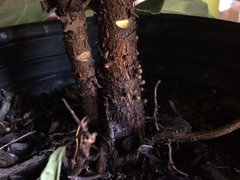


Rachel
6 years agoHi everyone. I'm wondering can I get some advice on my ailing plant?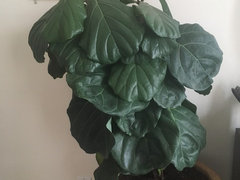
I repotted it about a month ago and this past week it's flopped to one side and gotten incredibly droopy. I think it's safe to say I did a bad job repotting it. Now I don't know whether to try again or let it recover? I'm worried it will die if I do nothing. About three leaves have dropped from the bottom so far.
thanks!tapla (mid-Michigan, USDA z5b-6a)
6 years agoAudrie - there are 3 ways to make a single trunk from your plant. A) cut the smaller trunk off immediately above the root to shoot transition and rub off all/any buds that break back near the wound site. B) Split the 2 trunks apart by making a vertical saw cut between the 2 trees. If there are 2 plants, there's a possibility you can pull the 2 trees apart, but you might need to remove some roots that are fused or that lock the tree together in something similar to the way animals in the Cervidae (deer) family might lock antlers. If you're inclined toward saving both of the individual trees, before you make the saw cut, determine that there is a volume of roots attached to both plants sufficient to ensure viability. There is no need to have a ton of roots on the smaller plant because that can be pruned back to the root to shoot ratio is appropriately balanced. C) Wrap the trunks together very tightly with grafting tape or 2" vet wrap. You'll be leaving them wrapped tightly until at least next fall. By then they should be fused. Eventually you'll cut the subordinate trunk back to a leaf growing away from the center of the composition, and instead of the trunk competing for your eye as the apex, it becomes a branch.
You can see what I mean in the mother/daughter composition below.
As you can see, there is no need to fuse the smaller trunk or remove it. Leaving it as is and pruning it as I described will solve the issue. You'll still have 2 trunks, but they work together to make a composition that will appear to be a single tree.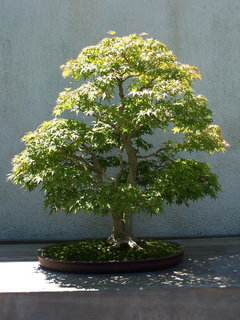
************************************************************************
Rachel - you can straighten the tree by digging out some of the siol on the tide it should tilt toward. Then, just grab the trunk and guide the root mass with your hands and reposition the tree in the pot, then backfill with appropriate soil. You can tie a rope around the pot just under the rim, then tie one end of another rope to the trunk opposite the way the tree wants to lean, and the other end gets tied to the rope encircling the outside of the pot.
See the hornbeam I dug from a raised bed last year. It's at the very beginning of being trained as a future bonsai. Note how it's secured in the pot. I did this because I hauled the tree 103 miles (one way) to get input about from other bonsai practitioners whose opinions I value. Originally, it had 3 trunks.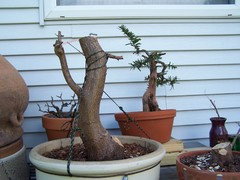

Al
Rachel
6 years agoThanks Al, I will do that! Is there anything I should worry about with the dropping leaves? Do you think repositioning the tree will make it happier?
tapla (mid-Michigan, USDA z5b-6a)
6 years agoR - there is always 'concern' when a tree is pitching a chronic fit and throwing its leaves on the floor. Growing well is a holistic thing, and you can bet all that Mother Nature is going to side with the hidden flaw. IOW, that factor that is most limiting might as well be the only thing that is limiting the plant's vitality. When you fix the most limiting factor, the factor that had the potential to be the second most limiting factor becomes THE most limiting factor.
If Joe wants to be a tennis player, but Joe's blind, it's a good bet the lack of ability to see might be the factor most limiting his potential. If he suddenly/miraculously has his sight restored, the fact he was born with only one leg could easily become the NEW 'most limiting' factor. If Joe gets fitted with a new prosthesis, the fact that Joe weighs 450 lbs might become the next most limiting factor ....... and so it goes with plants. There is actually a Law, called Liebig's Law of the Minimum that addresses and fleshes out this concept.
So, if light is an issue and you fix that issue, if the next most limiting factor is a near equal to the limitation imposed by poor light, it's not in the cards that you'll see a significant improvement. I frequently explain that what determines out proficiency as growers is how well we identify what is limiting our plants, and how effectively we eliminate or reduce to the greatest degree possible, those limiting factors. Unless we have a good idea what else has the potential to be almost as limiting as the most limiting factor, we can't even make an educated guess as to how much impact getting the light right is going to have on moving the plant in the right direction. ALL pieces of the puzzle are relevant and important.
What I said should be read as encouragement to keep focusing on learning all you can about potential limitations and developing strategies to eliminate them. Knowledge will carry you further and faster than years and years of accumulated experience gained by trial and error.
Al
robin98
6 years agoRachel, that's great! Did you do anything else to help it along, other than straighten it?
Rachel
6 years agoI replaced the soil that I dug out and added more in general, I realized it wasn't being supported as well as it could be. I also mixed in some perlite. I guess it was really just struggling before so some small changes made a lot of difference?
Rachel
6 years agoBack to my favourite thread with another question! I'm moving apartments this week, which means figuring out new spots for approx. 35 plants. It shouldn't be an issue for most of them, but I am concerned for my fiddle leaf.
We have two window aspects -- north and south, but here's the rub. I spent the whole day there yesterday cleaning, and noticed that the north-facing room was generally brighter all day, which I suppose is because the south side has a lot of tree coverage and two buildings on either side that are deeper than ours (joys of NYC). Anyway, it still surprised me.
I assume there will be some trial and error involved, but where do you think I should start with the plant? I've read conflicting accounts of the success of FLFs in a north-facing windows, so should I see how it goes on the south side first?
kdholland77
4 years agoCan anyone help me with this? I bought a fiddle leaf fig in the summer. It has one trunk that has two branches. One of the branches has produced new leaves which has caused it to droop. I'm not sure how to fix the drooping. Also, for aesthetics, should I prune the lower leaves to expose more of the trunk?
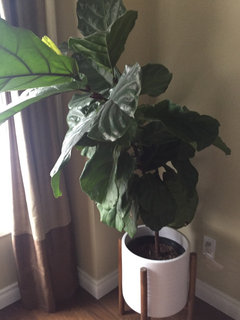
tapla (mid-Michigan, USDA z5b-6a)
4 years agoIt's an easy pruning fix, but how about some additional images so I can see what you're dealing with?
I don't know if Holland is your name or a geographical hint, but where you live can have a big impact on how you prune. I.e., if you live in Australia, major pruning now is ok (from the plant's perspective). If you live in the N Hemisphere more than 25* N latitude, you should probably only tip prune for now, which might be enough anyway after you provide additional images.
BTW, it hasn't been determined if the tree is flopping over due to a phototropic response (leaning toward the brightest light source) or because the trunk is too weak to support the weight of the foliage. In either case, pruning lower foliage would be decidedly counter-productive. Plants make their own food (sugar.photosynthate), and leaves are the factories in which the food is produced. Food that isn't immediately used for growth or to keep the plant's systems operating efficiently is stored in new cells the plant creates in cambial tissues (located just beneath the bark). These thicken the trunk, which means there is a very direct link between how strong the trunk is and how much foliage the tree has; and of course, how much food can be produced is directly linked to how much light falls on the leaves.
Al
kdholland77
4 years agoI am in Canada. The tree only started drooping when it got a new leaf and now it is developing another one so it's only getting worse. The tree is right beside a south-facing window, so maybe not a light issue?


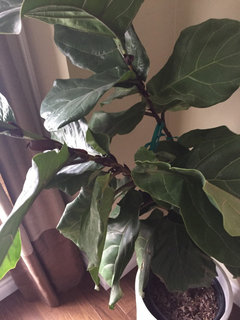
tapla (mid-Michigan, USDA z5b-6a)
4 years ago
I'll be referring to this image as I offer instructions re how to correct the leaning. I might also mention that trunks with movement (curves) are more interesting than those that are ramrod straight. Notice what looks like a small leaf that occurs immediately in the crotch (axil) of the bigger leaf immediately below the pruning cut. The small leaf is actually a new branch, and as it grows that new branch can easily be trained to a vertical attitude so it becomes the new leader/top of the tree. Not withstanding the effect of a phototropic response (the branch growing toward the light), we could reliably predict the branch will grow to the right. Had the pruning cut been just above the lower leaf on the left, a new branch would appear in the crotch of that leaf and predictably grow to the left. Based on this short tutorial on directional pruning, you can prune the stem/trunk now growing closest to vertical, back to a leaf that faces an imaginary line extending vertically from the point where the main trunk leaves the soil. What you'll be doing is setting the stage for the direction the main stem (the one closest to vertical) is growing to be reversed so it grows back toward the center axis of the tree's mass. If the tree grows left and you don't want it to, prune back to a leaf facing the right and it will change direction - thus, 'directional pruning'. You might need to reinforce the tree's willingness to cooperate by rotating it so the new branch that will occur will be growing toward the light source.
The other branch is easy. Tip prune it now (cut off the most distal leaf and the growing tip of the branch). Around the end of May, prune that branch back to 1 or 2 leaves. That is to say, cut back far enough so only 1 or 2 healthy leaves remain on the branch. If you can see scars on the branch close to the trunk where leaves have already been shed, cut back to 1 leaf. If there are no old leaf (bundle) scars, cut back to 2 healthy leaves. You will get a new branch from the axil of each of those leaves. From there forward, you can start pinching the tree. Pinching is simply removing the growing tip of every branch after it has grown 2 mature leaves. Pinching terminates branch extension and FORCES new branching to occur from leaf axils.
Example: The tip of this Ficus retusa cutting/branch/trunk was pinched. The predictable result is the new branches growing in the axils of each leaf.

Questions?
Al
K J
4 years agolast modified: 4 years agoHi everyone! I’m a few years late to the discussion but hoping for help. I took this plant from a friend who replanted into the pot shown and eventually stopped caring for it. There were brown edges from under watering so I cut them off because I didn’t like the look. That’s why you can see the leaves looking funky in the photo. The brown edges have not spread since I started caring for it.
I have been consistent with water and have received a new leaf on each stem since I got it! There’s a few leaves that have some spots. When all were baby leaves they looked similar to some posts here and some commenters mentioned as they grow they will get rid of the spots. See the first two pictures as shown. I’m wondering if I need to be concerned? There was a post about the leaf having a disease so I’m hoping to get others opinion.
In addition, I’m concerned about there being four stems. I understand as it grows the stem will grow and take up room. Should I separate the stems into separate pots now? Or should I let it be? I’m worried about it overgrowing and some leaves not getting the light it needs

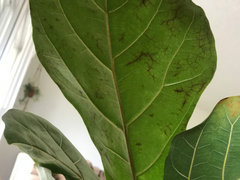
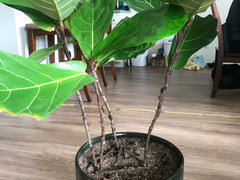
Matthew Galloway
4 years agoAl,
Have had a successful tree grow in our yard from 4t under a shade to a large thriving tree here in Tampa, FL
Started noticing as the tree continues to grow that the bottom leaves are starting to drop and either browning and turning yellow. Is that a natural progression of a tree? Or is there an issue facing? Also have something seeming to appear like roots growing around the trunk split. see photos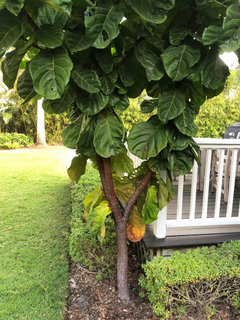

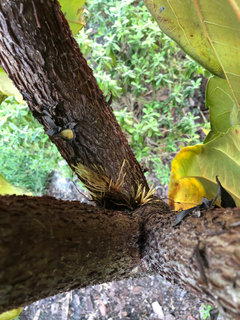
tapla (mid-Michigan, USDA z5b-6a)
4 years agoHi, KJ - 0nly have a few minutes now, so I'll address Matt's question and circle back to yours later today. In the meanwhile, maybe you'll get other advice.
"Started noticing as the tree continues to grow that the bottom leaves are starting to drop and either browning and turning yellow. Is that a natural progression of a tree? Or is there an issue facing? Also have something seeming to appear like roots growing around the trunk split. see photos."
The degree to which a leaf can 'acclimate' to changes in photo load is limited. IOW, you shouldn't expect a leaf that emerged under a full sun light load to acclimate to light levels in a dim corner, any more than you can expect a leaf that emerged in a dim corner to acclimate to a full sun site; this, no matter how long you allow for acclimatization. Too, the plant's ability to adapt to higher light loads is greater than its ability to adapt to lesser light loads.
Using a 1-10 numerical/hypothetical example (1 is low, 10 is high light) to illustrate: If a leaf emerges where the light level is measured at 5 units, it's range of adjustment might only be to 3.5 on the low side, but 8 to 8.5 on the high side. So, it's normal for lower leaves to be shed due to a reduction of light caused by shading from the canopy.
Also, a leaf's life span isn't a forever thing - they 'wear out'. Natural senescence (aging) can also cause shedding of older leaves.
The roots are adventitious roots - roots that appear from places you wouldn't expect them to - often referred to as aerial roots, or, in the case of Ficus, prop roots - because they appear to 'prop' up the tree when mature. In Ficus, they need high humidity to grow, so I'm guessing that dust and debris has collected in the trunk crotches and serve as a moisture reservoir. If they were growing downward from higher on the trunk (which they usually do), you might consider keeping them, but these should be removed. You might also find they originate from a wound site, but I can't see enough detail from the image.
Al
tapla (mid-Michigan, USDA z5b-6a)
4 years agolast modified: 4 years agoK J said: I took this plant from a friend who replanted into the pot shown and eventually stopped caring for it. There were brown edges from under watering so I cut them off because I didn’t like the look. That’s why you can see the leaves looking funky in the photo. The brown edges have not spread since I started caring for it. For the most part, F. lyrata quickly shed leaves when when asked to deal with an extended period of dry soil, this, as a drought response which helps the plant conserve valuable moisture it needs to remain viable. Typically, plants that have been over-watered and sometimes unevenly watered, will also show necrotic (dead) areas at the plant's extremes, which would be leaf tips (if there are leaf tips) and/or leaf margins (edges). An overly high level of dissolved solids (salts) in the soil solution can cause or contribute to the leaf damage at the margins/tips due to the fact a high level of dissolved solids makes it more difficult for the plant to efficiently move water, especially to it's most distal parts - leaf margins, in your case. Regardless of the cause, it's fixable, and I can help you work out a plan that should have your plant well on the road to a much better state of vitality by mid-summer, and that's very fast according to 'tree time'.
I have been consistent with water and have received a new leaf on each stem since I got it! If by 'consistent', you mean you water regularly as clockwork, I'd suggest you: A) Change your medium to one which allows you to water nearly at will, but without the need to be worried about prolonged periods of saturated soil limiting the roots ability to function efficiently, or worse, setting the stage for any of several fungal root infections. I grow in those types of soils. I can water everything on a schedule and not be worried about over-watering; or B) Start watering on an as needed basis and start using a 'tell' to 'tell' you when it's time to water. See more about using a tell below. There’s a few leaves that have some spots. In addition to the dieback of leaf margins resultant of trimming off the crispy edges, I do see what looks like mechanical injuries (the equivalent of bruising in animals) on some of the leaves. The first image REALLY looks like mechanical injury. For the second image is harder to tell. It appears that there are small dead areas where the leaf was bent to the degree small cracks appeared in the leaf cuticle (skin). This also happens if the humidity is too low (from the plant's perspective) when the leaf is unfurling. When all were baby leaves they looked similar to some posts here and some commenters mentioned as they grow they will get rid of the spots. See the first two pictures as shown. I’m wondering if I need to be concerned? No need for concern at this point, unless it continues, but we're going to work on that, if you're game. The red/purple/brown dots that are often seen in juvenile leaves are expression of a purple pigment (anthocyanin), and goes away as the leaf matures and chlorophyll (a green pigment) masks the temporary expression of the purple pigment. There was a post about the leaf having a disease so I’m hoping to get others opinion. I don't see anything that looks like you should be worried about a disease, unless you have something cooking in the rootzone now. In order for a plant to be healthy, it's essential, mandatory, a prerequisite, that the root system is healthy. An extremely high % (90+?) of the problems that bring people here for help are related to unhealthy roots.
In addition, I’m concerned about there being four stems. I understand as it grows the stem will grow and take up room. Should I separate the stems into separate pots now? Or should I let it be? I’m worried about it overgrowing and some leaves not getting the light it needs. I could write a book on these questions alone, so I'll try to answer briefly on a per sentence basis. The only problem I personally see with the number of trunks is an esthetic issue of little concern. An even number of trunks (other than 2) is generally less appealing to the eye, so I'd be all for potting the trunks up individually, or, remove either 1 or 2 plants from the composition. I would not split the 2 trunks closest together unless you go for all 4 as individuals. Now isn't the best time to repot or separate the plants. For most of the US and all of Canada, June would be better - think summer solstice or Father's Day as a target date. Finally - no need to worry about it overgrowing and some leaves not getting the light it needs, if, you repot at appropriate intervals so root congestion doesn't become severely limiting, and gently guide the trunks into the position that best compliments the composition. As new branches appear, you can use directional pruning and a little judicious guidance with guide lines to make sure branches are growing toward voids in the canopy where light is plenteous.
Hopefully, that will give you something to think about. Let me know if you have questions or need more direction in specific areas.
Using a 'tell'
Over-watering saps vitality and is one of the most common plant assassins, so learning to avoid it is worth the small effort. Plants make and store their own energy source – photosynthate - (sugar/glucose). Functioning roots need energy to drive their metabolic processes, and in order to get it, they use oxygen to burn (oxidize) their food. From this, we can see that terrestrial plants need air (oxygen) in the soil to drive root function. Many off-the-shelf soils hold too much water and not enough air to support good root health, which is a prerequisite to a healthy plant. Watering in small sips leads to a build-up of dissolved solids (salts) in the soil, which limits a plant's ability to absorb water – so watering in sips simply moves us to the other horn of a dilemma. It creates another problem that requires resolution. Better, would be to simply adopt a soil that drains well enough to allow watering to beyond the saturation point, so we're flushing the soil of accumulating dissolved solids whenever we water; this, w/o the plant being forced to pay a tax in the form of reduced vitality, due to prolong periods of soil saturation. Sometimes, though, that's not a course we can immediately steer, which makes controlling how often we water a very important factor.
In many cases, we can judge whether or not a planting needs watering by hefting the pot. This is especially true if the pot is made from light material, like plastic, but doesn't work (as) well when the pot is made from heavier material, like clay, or when the size/weight of the pot precludes grabbing it with one hand to judge its weight and gauge the need for water.
Fingers stuck an inch or two into the soil work ok for shallow pots, but not for deep pots. Deep pots might have 3 or more inches of soil that feels totally dry, while the lower several inches of the soil is 100% saturated. Obviously, the lack of oxygen in the root zone situation can wreak havoc with root health and cause the loss of a very notable measure of your plant's potential. Inexpensive watering meters don't even measure moisture levels, they measure electrical conductivity. Clean the tip and insert it into a cup of distilled water and witness the fact it reads 'DRY'.
One of the most reliable methods of checking a planting's need for water is using a 'tell'. You can use a bamboo skewer in a pinch, but a wooden dowel rod of about 5/16” (75-85mm) would work better. They usually come 48” (120cm) long and can usually be cut in half and serve as a pair. Sharpen all 4 ends in a pencil sharpener and slightly blunt the tip so it's about the diameter of the head on a straight pin. Push the wooden tell deep into the soil. Don't worry, it won't harm the root system. If the plant is quite root-bound, you might need to try several places until you find one where you can push it all the way to the pot's bottom. Leave it a few seconds, then withdraw it and inspect the tip for moisture. For most plantings, withhold water until the tell comes out dry or nearly so. If you see signs of wilting, adjust the interval between waterings so drought stress isn't a recurring issue.
Al
K J
4 years agoHi Al-
This is all very informative for me. I will definitely take your suggestions and think about it. I’m leaning towards leaving all four stems and working with the plant to grow in the way I like asthetically.
As as far as watering and having a tell - I did the classic 1-2 inch tell and watered from there. I will switch that method since the pot I have is enormous and the top most likely does not represent the same as the bottom. It is in a very heavy ceramic pot so feeling for weight also isn’t an option.
Upon reading your answer I do have two more questions. Since the pot is so big - should I move to a smaller pot? It is 12 inches on top and bottom. In addition, I have no idea the type of soil she used prior to getting the plant. Should I look into new soil come June? If the ready-made soil isn’t great - what type of “recipe” would you suggest I follow? I guess that’s 3 questions! Thank you!tapla (mid-Michigan, USDA z5b-6a)
4 years agolast modified: 4 years agoI’m leaning towards leaving all four stems and working with the plant to grow in the way I like aesthetically. Of course, whatever you you prefer is fine.Let me know if you need any guidance when it comes time to prune.
As as far as watering and having a tell - I did the classic 1-2 inch tell and watered from there. I will switch that method since the pot I have is enormous and the top most likely does not represent the same as the bottom. I noticed the size of the pot right away, so I think changing to using a 'tell' will be very telling. I bet your watering intervals are at least twice what they were.
Upon reading your answer I do have two more questions. Since the pot is so big - should I move to a smaller pot? It is 12 inches on top and bottom. In addition, I have no idea the type of soil she used prior to getting the plant. Should I look into new soil come June? It doesn't take a large root system to provide water/nutrients to a planting with the amount of mass yours have, so there's significant potential for limitations associated with over-potting. Keep in mind that watering habits ans soil choice are key in determining whether or not a plant is over-potted. If by chance you're NOT over-watering and you have figured out a way to ensure there is no accumulation of salts occurring, it wouldn't be over-potted. The 2 soil types I make/use are open (porous - fast-draining) enough that it would be very difficult to make a case that a tiny seedling in 25 gallons of soil would be over-potted.


I think, if you flush the soil, start fertilizing, and make sure your watering is controlled, you can easily get by until summer, but repotting into a better medium is something I would definitely put on my list of things to do in order to turn things around. In the meantime, you might be able to make very good use of ballast in the bottom of the pot. Let me know if you want to explore that option.
If the ready-made soil isn’t great - what type of “recipe” would you suggest I follow? I guess that’s 3 questions! Thank you! Well, soil choice just might be the most important piece of the container-growing puzzle. A truly good medium makes it MUCH easier to water/fertilize correctly and to keep plants healthy/looking vibrant. If you love the nurturing aspect of growing things and enjoy the satisfaction that you get from seeing things respond favorably to you,
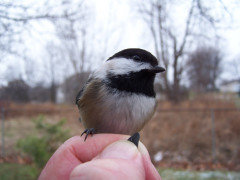
the right soil is worth the effort. Not having to fight your soil on a daily basis for control of your plants' vitality is a true blessing.
I can't suggest an off-the-shelf medium I would consider to be a 'good' soil. Fafard used to make several bagged mixes that were good, but since they were acquired by Scotts/Miracle-Gro, they no longer offer truly coarse bark-based mixes. What I can tell you is how to get very good results with almost no extra effort from a soil most would consider mediocre.
I have no idea what effect the CV-19 will have had on us by the time the dust settles, but if you find a source for pine bark that looks like what you see at 3, 6, and 9 o'clock, you can very easily make your own. The image in the middle illustrates what it looks like when dry.
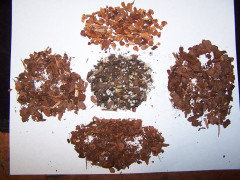
Maybe we can figure out a plan as we get closer to repot time.
Al
K J
4 years agoI’m excited come June to switch the medium and hopefully see the change within the plant. Admittedly, I’m not much of a green thumb but the only way I can become one is to keep learning. I’ve enjoyed all the tips and tricks you’ve so generously taken the time to share! Thank you and stay safe and healthy, Al!
tapla (mid-Michigan, USDA z5b-6a)
4 years agoThanks for the kind words; and I agree that you have the right idea (keep learning). Let me muse a bit ..... When it comes to green thumbs, I've come to realize there are 2 ways of getting there. One is by trial and error - we learn something is wrong only when we're being bit on the butt by our mistakes. When we touch a hot stove, we quickly learn a lesson because the reason is painfully clear. ..... not so when you're growing things. Examples: A) most hobby growers don't understand that over-watering causes the same symptoms as under-watering. The thought process: "Oh! Wilt. Hmmmm. More water! This, never considering the soil is already saturated. If, however, they know in advance that over-watering causes wilting, they save themselves the trouble of being bit on the butt by that mistake, thanks to the knowledge already part of their skillset. Imagine a chronic over-waterer trying to learn by trial and error that over-watering causes wilt. One might need to wait until some event keeps the grower from watering too soon, and the grower needs to recognize/associate the reason his/her plant looks better with the increased watering interval. That might never happen. B) Probably fewer than 1 in 10,000 hobby growers knows how to utilize ballast in the bottom of a pot. Ballast can allow very good results from very mediocre soils. The average hobby grower would never think to use ballast except to stabilized pots to keep them from tipping - even then it might not be used to the planting's advantage. Explaining how to use ballast and why it works provides a giant step forward on the path to green thumb status. This list goes on and on.
I guess my point is, it's not how long you've been growing things that advances you along the path to green thumb status, it's what you know about plants and what they want/need, plus, how effectively you apply what you know. So, instead of flailing around with the trial and error crowd, keep learning all you can; then, instead of wasting time on trial and error, not understanding what you're seeing anyway, use your practical experience (this would be other's trial and error 'experience') as a way to validate what you already know. Experience isn't worth much if, even for 100 years, we're doing the same thing and making the same mistakes over and over again.
Keep learning, and I promise, you'll leave trial and error green thumb seekers standing in your slipstream.
I hope you fare well. If you stick around the fora, I'm sure our paths will cross again. Best luck.
Al
C Hub
3 years agoHi all, enjoyed this thread. Bought a small one 2 years ago, it is ceiling height now and has thrived in our conditions. I‘m now thinking more about ongoing management now that it is as tall as I’d like. It’s in a 12” terracotta pot in pro mix with some added worm castings. The terra-cotta helps to avoid water logged soils and is more permeable for gas exchange.
I’ve been gardening all my life, literally, and raised in a family of professional and hobby horticulturalists. Nonetheless, I’m constantly learning how to provide optimal conditions and management for various genera. That’s just along the lines of comments above. It’s great when you progress to a point where you’re really competent at growing great specimens. But it’s ongoing, there are always more challenges. my orchid and bonsai hobbies really took me to the next level skill-wise.
orchids are very diverse. My collection requires several different environments and once you get that right, its straightforward. same for F lyrata. id really struggle though in western states with a dry climate. I also have excellent well water at 100 ppm and 7 pH. Makes it easy to adjust for sensitive plants.
I found my F lyrata to do well in a S facing window when it was grown from 3’ high to 6’ There isn’t much I’d grow in that location, but this one thrived there with proper air movement, watering and regular fert at lower levels, like 50 ppm N.
Al, when you talk about ballast, aside from using for stability, are you talking about a very coarse drainage layer? Like the size of RR ballast? I use lava rock for this, particularly w cattleya in 6” terracotta orchid pots. The slotted Sides and 2”+ rock really help w quick dry cycles.
thanks all for the great info. F lyrata is very satisfying to grow out, it’s a dramatic plant. Hope i can keep it happy in its new E window, may have to supplement w lighttapla (mid-Michigan, USDA z5b-6a)
3 years agoAl, when you talk about ballast, aside from using for stability, are you talking about a very coarse drainage layer? Like the size of RR ballast? I use lava rock for this, particularly w cattleya in 6” terracotta orchid pots. The slotted Sides and 2”+ rock really help w quick dry cycles. A wide variety of materials/items can be used asballast, and many materials can be used either as ballast or "drainage layers". I put the quotes around "drainage layers" to highlight the fact that drainage layers of any material that doesn't allow an unbroken column of substrate from the top of the column to the bottom of the pot can cause water to "perch" in the soil immediately above the "drainage layer", like a bird perches on a wire.
There are 3 pots below, all full of soil. The shaded area represents the PWT. Note what happens when a coarse drainage layer is used below the substrate. The water 'perches' above the layer, so instead of helping things by adding the "drainage layer, we've added to the potential for even more severe limitations.

The bricks displace about 25% of the substrate within the PWT zone. If we turn the bricks on edge and add a few more, making sure we have an uninterrupted soil column all the way to the pot bottom, we can eliminate >95% of perched water - passively. If we simply fill the bottom of the pot with bricks - water will simply perch in the substrate above the bricks.
Ifyou want the pot to be lighter, you can buy a bag of 20 plastic kids building blocks at a dollar store and use those.
The type of water retention it's best to avoid is driven primarily by substrate particle size. Once the spaces between larger soil particles are all full of fine material (<.100") the substrate begins to hold perched water (PW). The finer the material and the larger the fraction of fine material, the taller will be the PW table (PWT) a soil will hold. PW is water held between substrate particles, water that refuses to drain from the substrate when acted upon by gravity, because the sum of the forces of adhesion and cohesion (the tendency for water to stick to other materials and itself, respectively) are greater than the force of gravity. It's not unusual for off the shelf potting substrates to support 4-6" of PW, which represents a severe handicap when we consider good root health is a prerequisite to a healthy plant.
One of the physical properties of substrates that hold PW is that for any given substrate which supports PW, the ht of the PWT will be the same (at container capacity) no matter the size or shape of the pot (practically speaking). A volume of ballast added to the bottom of a pot displaces an equal volume of substrate that would otherwise be saturated with water (at container capacity).
Al
DaniHeath1999 .
3 years agolast modified: 3 years agoHey guys,
I'm hoping someone can help me with my new FLF!
So I ordered a FLF from this lovely shop online but was disappointed when it came as it was very skinny and sparse. The shop absolutely agreed after I sent photos that this was not up to their standards and have very kindly agreed to send me a new FLF in the next week or so .
BUT that means I am now the owner and caregiver to this very skinny and sparse little FLF. So I am hoping you guys can help me take care of him and help him thrive. Here are my queries below...
- He came attached to a bamboo support which I have since removed as the poor guy is just so so skinny. He does sometimes wobble a little which worries me but I'm hoping this will help get him to support himself better. Any thoughts?
- He has some damage to his uppermost leaves (pictured below) and I'm wondering (as the customer service lady recommended) whether I should chop the trunk about 5 inches from the top in order to promote healthier growth? (I also wonder if this will help with his wobbly wobbly trunk become more stable)
- There are no leaves for about 6-8inches near the bottom of his trunk. Is there anything I can do/you'd recommend to promote new leaf growth down there as I prefer a bushier look and you can see that a previous stem has been chopped off at that point (bless him)?
- One of his leaves' stems is actually under the soil. I've tried brushing the soil away but I think the stem begins fairly low down below the soil line. I don't want to stress the poor guy out but I'm guessing a leaf in soil is not great. What would you recommend I do?
- Finally, I'm wondering if it's possible and then whether it's advisable to pot him with my other FLF which will be arriving in a few weeks. There are a few reasons for this - I prefer the bushier look (I've attached a photo of what I had expected to arrive), I only have limited space and only wanted one plant as a result and also the ideal position to keep the FLF in my flat is this very bright south-east facing window so having both together would be great for all these problems. BUT I don't want to risk stressing this little guy out too much and I definitely don't want to risk killing him if this isn't advisable! Let me know as I've been really considering it recently but can only find advice on how to separate two plants!
Thanks in advance for the advice and for taking an interest in helping this skinny boy thrive!
Amanda Marnik
3 years agoThis seems to be the most informative forum I can find on this plant, so I am asking for advice also! I bought this plant in the spring, and I cannot get it to grow larger leaves, nor can I figure out why it has so many stems when no others I have seen have more than two. Help?
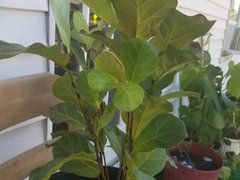
tapla (mid-Michigan, USDA z5b-6a)
3 years agoI bought this plant in the spring, and I cannot get it to grow larger leaves, nor can I figure out why it has so many stems when no others I have seen have more than two.
The Ficus genus is genetically programmed such that each consecutive leaf on any given branch or stem will be larger than the last if the plant isn't suffering culturally. Stunted leaves are common when over or under-watering stress affects the plant's ability to grow normally.
Often, when cuttings are stuck (planted), several nodes with latent buds might be buried below the soil. This can/does lead to growth of what we might 'think' are multiple trunks but are actually branches growing from the main stem of the propagule. Example:
This ^^^ rooted cutting has 2 new branches forming in the axils of both mature leaves, If I removed the mature leaves from it and buried it to the top of the short stub above the top leaf, it would produce what you would consider to be 2 trunks, but what would actually be 2 branches growing from the main stem of the propagule. It's not unusual to get what appears to be 5 or 6 "trunks", or even more, when only 2 propagules were stuck.
AlGina (MD-7b) Mc
3 years agolast modified: 3 years agoHi everyone, this forum has been so very helpful, and I’ve been trying to soak up all the info. Al, your article on soil (and all your advice to everyone here) has been REALLY helpful! I’ve also now learned the difference between repotting and potting up. I am hoping to get some specific help with my F lyrata. (Maybe I’ll be back for advice on my Ficus Elastica Ruby)
It was gifted to me by my MIL after her new kitten decided to use it as a litter box. She only had it about 6-8 months (?) so I imagine all she did was pot up from the nursery pot into this large pot. I now have it in a south facing window, that is mostly covered by a light filtering shade, 4 feet from a west facing window in a fairly bright room, and next to a humidifier. I wondered if I did a full repot and root trim if I could possibly put it in a slightly smaller pot? I plan to use a mixture of 1:1:1 potting soil, perlite, and repti-bark, and possible put some empty bottles in the bottom as ballast.
I also hoped to turn it into a standard or “mother/daughter”. It has 6 stems that all seem to be from the same plant and I wonder what the best way to convert it would be? I read about removing stems to accomplish this but also about leaving stems, because those leaves have value to the plant, while you focus on strengthening one stem or binding a few together? Honestly, I just read so much information at once in the past couple days that I am a little overwhelmed :) I would like to give it the correct soil and conditions for it to thrive. It is currently bushy, with a couple sad leaves, and all the branches flop over. I don’t want to stress it out, just want to head in the right direction. Is it too late for a repot and root pruning in zone 7b?
TIA for your time!
Gina
EDIT: I asked my MIL and she said the nursery pot was probably half (!!) the size of the current pot, and she used just regular potting soil/miracle grow.
tapla (mid-Michigan, USDA z5b-6a)
3 years agoHi, Gina - thank you for the kind words.
I now have it in a south facing window, that is mostly covered by a light filtering shade, 4 feet from a west facing window in a fairly bright room, and next to a humidifier. So it's sort of between a S and W window? I wondered if I did a full repot and root trim if I could possibly put it in a slightly smaller pot? I plan to use a mixture of 1:1:1 potting soil, perlite, and repti-bark, and possible put some empty bottles in the bottom as ballast. Yes, you'll be able to put it in a smaller pot after the root reduction, but do make sure you don't cut yourself short insofar as space for roots to run, given you'll be adding ballast.I also hoped to turn it into a standard or “mother/daughter”. It has 6 stems that all seem to be from the same plant and I wonder what the best way to convert it would be? A mother/daughter arrangement would look like the larger tree hovers protectively over the daughter tree. When you select the two trees, be sure the larger doesn't dirsctly overhang the smaller and shade it out. The two should be offset a bit. This can usually be accomplished best by allowing the two trunk lines to be directly above each other for a distance before the daughter's trunk turns toward you. This arrangement has a front and a back for viewing purposes, but it should be rotated regularly so all sides get their share of light. Remove the surplus stems.branches unnecessary to the composition by pruning them back to the trunk. Start them as cuttings if you like. I read about removing stems to accomplish this but also about leaving stems, because those leaves have value to the plant, while you focus on strengthening one stem or binding a few together? Honestly, I just read so much information at once in the past couple days that I am a little overwhelmed :) Not pertinent at this point - save that for later. I would like to give it the correct soil and conditions for it to thrive. I think you can expect good results with what you proposed above, and the ballast will definitely work in your favor. Is it too late for a repot and root pruning in zone 7b? If there was no pressure to get the plant out of the pot/soil it's in now, I'd probably wait. If you think the combination has potential to dump a serious problem before next spring, go ahead and repot. It would be best if, after the repot, the plant could be sited outdoors in dappled or open shade and out of wind while it recovers. You have a longer growing season than I do and I set Aug 1 as my last repot date for Ficus ..... but all my trees are outdoors, which makes a very significant difference. Start fertilizing when you're seeing new growth. Make sure you keep the roots WET for the entire duration of the repotting session. Have everything ready to go before you start. Add a wick to the pot too, if you like.
Questions?
Al







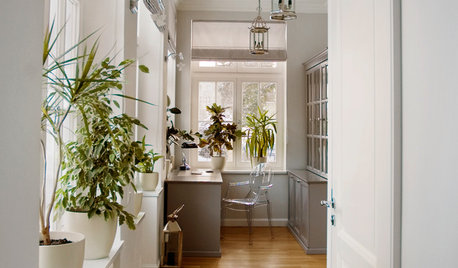









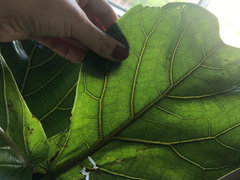
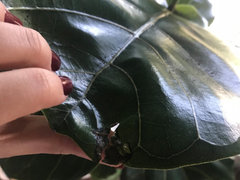
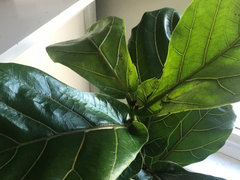
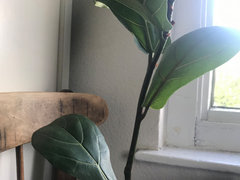

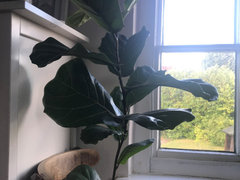

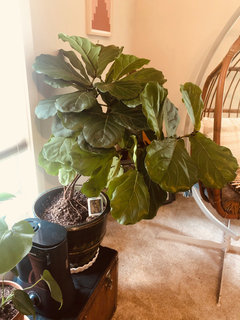


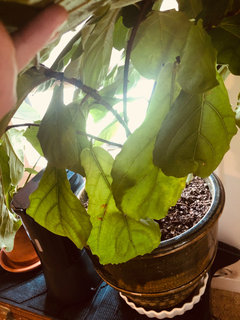






tapla (mid-Michigan, USDA z5b-6a)